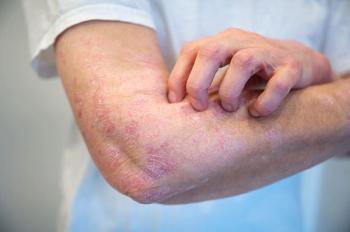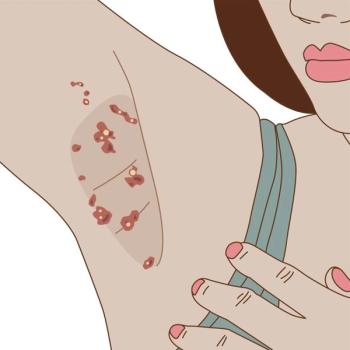
Erythema Annulare Centrifugum
For 5 weeks, a 27-year-old man had a rash with painful fissures on his hands. For the past 2 weeks, he also had mildly pruritic red, scaly lesions on his trunk. He was otherwise healthy, had no allergies, and did not take any medications. The patient denied the use of tobacco, alcohol, and illicit drugs.
For 5 weeks, a 27-year-old man had a rash with painful fissures on his hands (A). For the past 2 weeks, he also had mildly pruritic red, scaly lesions on his trunk (B and C). He was otherwise healthy, had no allergies, and did not take any medications. The patient denied the use of tobacco, alcohol, and illicit drugs.
The truncal rash consisted of both annular and polycyclic erythematous plaques with raised borders and trailing scales. There were no vesicles or crust. The palms were mildly erythematous with hyperkeratotic scales and fissuring. Histopathological examination of a punch biopsy specimen from the patient’s back revealed dilated blood vessels in the superficial and mid dermis surrounded by numerous lymphocytes arranged in a “coatsleeve” pattern, and mild focal spongiosis in the epidermis with scant parakeratosis. These findings were consistent with erythema annulare centrifugum.
Further questioning revealed that the patient also had hyperkeratotic scaling of his feet (D). A potassium hydroxide preparation of skin scrapings from the left hand showed hyphae. Tinea mannum and tinea pedis were also diagnosed. The patient was treated with oral terbinafine for 1 month with daily application of sertaconazole cream to the hands and feet.
After 2 weeks of treatment, the rash had nearly cleared (E); however, there were areas of postinflammatory hyperpigmentation on the trunk (F). The patient was advised to complete the course of terbinafine and continue the topical antifungal as needed.
Erythema annulare centrifugum is thought to represent a reactive process or antigenic “hypersensitivity” reaction. Although it is often idiopathic, erythema annulare centrifugum has been associated with dermatophytosis.1 Other reported associations include infectious agents, such as Candida albicans, Phthirus pubis, and Escherichiacoli2-4; ingestion of molds, tomatoes, and medications; long-standing diseases; and malignancy.5,6
The incidence of erythema annulare centrifugum is highest during the fifth decade of life; however, the condition can occur at any age. There is no gender predilection.7
The lesions begin as pink papules that grow 2 to 3 mm per day and then develop a central clearing. Trailing scale on the inner border of the annular erythema is characteristic. The plaques are minimally elevated and typically lack crusts or vesicles.5,7 The rash generally affects the trunk, buttocks,
and proximal extremities and spares the mucous membranes.
Erythema annulare centrifugum is often self-limited, although it can be a chronic and relapsing disease. Treatment of the underlying condition, if prese
nt, is the goal. Some authors have even supported the use of antifungal agents as empirical treatment. Topical and oral corticosteroids, as well as tar ointments, may be used. Oral antihistamines for pruritus should be considered. Other treatments include interferon-α, dapsone, etanercept, and metronidazole.7-9
References:
REFERENCES:
1.
Mahood JM. Erythema annulare centrifugum: a review of 24 cases withspecial reference to its association with underlying disease.
Clin Exp Dermatol.
1983;8:383-387.
2.
Schmid MH, Wollenberg A, Sander CA, Beiber T. Erythema annulare centrifugumand intestinal Candida albicans infection-coincidence or connection?
Acta Derm Venereol.
1997;77:93-94.
3.
Bessis D, Chraibi H, Guillot B, Guilhou JJ. Erythemaannulare centrifugum induced by generalized
Phthirus pubis
infestation.
Br J Dermatol.
2003;149:1291.
4.
Borbujo J, de Miguel C, Lopez A, et al. Erythemaannulare centrifugum and
Escherichia coli
urinaryinfection.
Lancet.
1996;347:897-898.
5.
Odom RB, James WD, Berger TG, eds. Andrews’
Diseases of the Skin: Clinical Dermatology.
10th ed.Philadelphia: WB Saunders; 2006:303-306.
6.
Tsuji T, Kadoya A. Erythema annulare centrifugumassociated with liver disease.
Arch Dermatol.
1986;122:1239-1240.
7.
Espana A. Erythemas. In: Bolognia JL, Jorizzo JL,Rapini RP, eds.
Dermatology.
London: Mosby; 2003:303-306.
8.
Dippel E, Orfanos CE, Zouboulis C. Linear IgAdermatosis presenting with erythema annulare centrifugumlesions: report of three cases in adults.
J Eur Acad Dermatol Venereol.
2001;15:167-170.
9.
Minni J, Sarro R. A novel therapeutic approach toerythema annulare centrifugum.
J Am Acad Dermatol.
2006;54:S134-S135.
Newsletter
Enhance your clinical practice with the Patient Care newsletter, offering the latest evidence-based guidelines, diagnostic insights, and treatment strategies for primary care physicians.


















































































































































































































































































